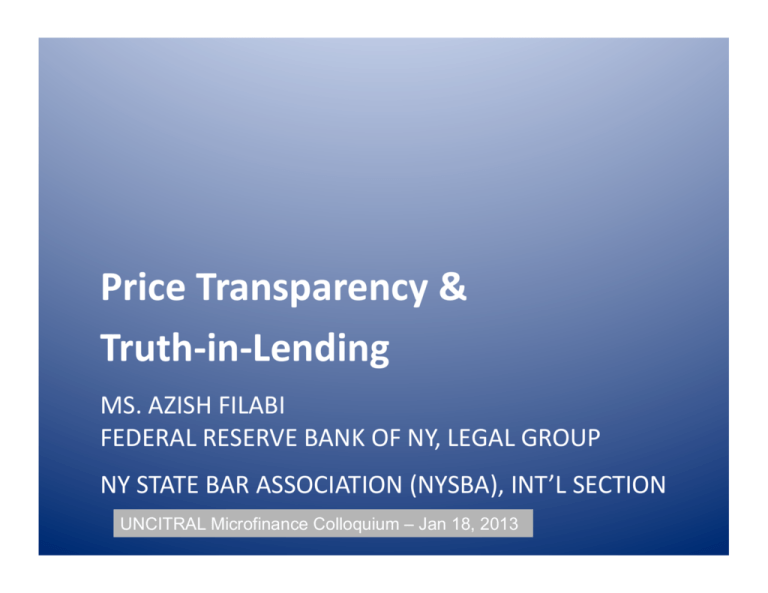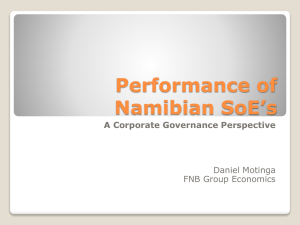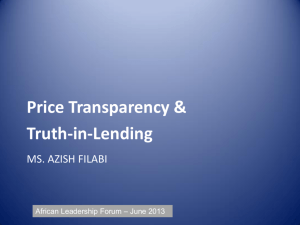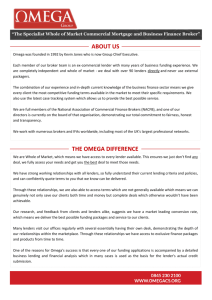Price Transparency & Truth-‐in-‐Lending
advertisement

Price Transparency & Truth-­‐in-­‐Lending MS. AZISH FILABI FEDERAL RESERVE BANK OF NY, LEGAL GROUP NY STATE BAR ASSOCIATION (NYSBA), INT’L SECTION UNCITRAL Microfinance Colloquium – Jan 18, 2013 Disclaimer The views expressed in this presentaMon are solely my own and do not represent the Federal Reserve Bank of NY or the NY State Bar AssociaMon Why is transparency important? Hidden Prices!! Importance of Transparency AS RECOGNIZED BY THE INDUSTRY • Smart Campaign – Client ProtecMon Principles – 2 of the 9 Principles include Transparency, and Responsible Pricing – Self-­‐cerMficaMon, and recently third party cerMficaMon launched – www.smartcampaign.org • Banana Skins reports: – ReputaMon risk (2011) and poliMcal interference (2012) – These reports are wri`en by pracMMoners in the microfinance industry based on informaMon received by surveys of various stakeholders – Increasing percepMon that MFIs engage in abusive pracMces – RecogniMon that abusive pracMces are not only detrimental to the client but also to the long-­‐term credibility of microfinance – h`p://www.ciMgroup.com/ciM/microfinance/data/news110125b.pdf • Microfinance RaMng Agencies – Planet RaMng/Microrate/Microfinanza: Specialize in raMng MFIs – Have added (as of 2012) client protecMon (including transparency, responsible pricing and effecMve complaint resoluMon) as a pillar of an MFI raMng – “An MFI lives in symbiosis with its clients and its asset quality is notably based on the trust relaMonship created with its clients”. Planet Ra.ng – “Client protecMon and other social measures are essenMal to the long-­‐term success of the business…” Microfinanza Importance of Transparency AS REPORTED BY THE SECRETARIAT • “A recurring theme [of the 1st Int’l Colloquium on Microfinance in 2011] was the need for measures to ensure client protec7on, including the prevenMon of unscrupulous pracMces and the building of financial literacy in the community generally” • “As noted, self-­‐regula7on by itself is no longer sufficient and there is an increasing consensus on the need to follow the principles of responsible finance.” • “More generally the need for transparency (e.g. interest rate disclosure, complaint procedures) in the microfinance sector was flagged.” Note by Secretariat (summary of First Int’l Colloquium on Microfinance), Legal and regulatory issues surrounding microfinance, A/CN.9/727 (2011) Importance of Transparency OTHER REPORTS • “Countries with a strong insMtuMonal framework for microfinance (as defined by the Microscope) tend to reach more borrowers than countries with weaker insMtuMonal condiMons. This observaMon especially holds true for countries with transparent pricing regulaMons and good dispute resoluMon mechanisms.” Global microscope on the microfinance business environment (2012), Economist Intelligence Unit. www.eiu.com/microscope2012 Is Self-­‐RegulaMon Sufficient? • Misaligned incenMves: – Creditors/lenders – want to reach more clients – Investors – want higher volume and higher returns – Client – wants the best deal, but no access to info • Mandatory parMcipaMon required for a disclosure regime to work efficiently – Self-­‐regulaMon is voluntary – Transparency works best when consistent -­‐-­‐ when clients can compare a product across all lenders and receive the same informaMon, ideally in the same format • No legal enforcement mechanism – Reliance on market forces to disMnguish among MFIs Is Self-­‐RegulaMon Sufficient? • No legal enforcement mechanism – Reliance on market forces to disMnguish among MFIs • The main benefits to compeMMon and fair access come from all lenders adhering to the same rules Self-­‐regulaMon demonstrates a commitment to responsible finance, which is a important step for truth-­‐in-­‐ lending laws to work effecMvely Transparent to whom? Stakeholder: • Clients • Investors/Donors • Regulators • Other MFIs/Market Incen7ve: Client ProtecMon Mission-­‐driven Compliance; stability Facilitate compeMMon UNCITRAL Working Group • UNCITRAL is already acMve in areas that impact microfinance – Secured TransacMons: The scope of the LegislaMve Guide to Secured TransacMons includes microfinance transacMons when there’s collateral • It does not, however, address pricing disclosure, or abusive collecMon – Dispute ResoluMon – E-­‐commerce • Balance “over regulaMon” with “under regulaMon” – Timing of implementaMon will be country-­‐specific: legislators, regulators, and local organizaMons are the best posiMoned to determine implementaMon but UNCITRAL is best posiMon to provide standards UNCITRAL Working Group • PotenMal approaches for a WG on Microfinance and Related Topics: – LegislaMve Guide -­‐-­‐ enables legislators and regulators to implement transparency regimes • Opportunity to idenMfy best pracMces among countries and incorporate in to a Guide – Model contract provisions • Assists implementaMon of transparency in creditor/ debtor relaMonships UNCITRAL Working Group • Transparency is not an issue of prudenMal regulaMon – PrudenMal regulaMon safety & soundness of deposit-­‐taking enMMes, and systemic risk regulaMon of the macro-­‐economy • PrudenMal regulaMon already addressed by Basel Commi`ee on Banking Supervision’s Microfinance Ac.vi.es and the Core Principles for Effec.ve Regula.on • www.bis.org/publ/bcbs175.htm Legal ConsideraMons Legal ConsideraMons 1. 2. 3. 4. Standard Pricing Formulas Standard Repayment Schedules Enforcement & SancMons Financial EducaMon/CommunicaMon Mechanisms 1. Standard Pricing Formulas • Why a standard formula? – Beneficial to clients when all lenders use the same formula – Disclosure is most effecMve in increasing compeMMon when there’s a standard for all lenders – One reason why self-­‐regulaMon may not be sufficient • What disclosure standard? – Nominal rates: widely dismissed because it does not provide adequate disclosure of the “real” rate – APR vs. EIR vs. Total Cost of Credit? – Should flat interest rates be prohibited in all cases? – Mandatory savings accounts to be included in cost calculaMons in all cases? 1. Standard Pricing Formulas • What fees disclosed? – Best pracMce would require ALL originaMon or repayment fees to be communicated • Other pricing issues to consider: – Should all interest on savings be compounded? – Security deposits – when is it used as collateral? • How to best disclose bundled services?: – Insurance – Mandatory savings; voluntary savings 1. Standard Pricing Formulas • Other Terms & CondiMons – Prepayment penalMes? – Variable interest rates? • ConsideraMons for the working group: – How specific should the regulaMons be? (i.e., what should be ler to lender discreMon vs. codified in the law?) – Should any loan features be prohibited? Legal ConsideraMons 1. 2. 3. 4. Standard Pricing Formulas Standard Repayment Schedules Enforcement & SancMons Financial EducaMon/CommunicaMon Mechanisms 2. Standard Repayment Schedules • Why standard? – Standard forms make it easier to compare across lenders, irrespecMve of enMty type – For illiterate clients, a standard form makes it easier to compare offerings even if they don’t necessarily understand all the terms 2. Standard Repayment Schedules • Should forms be mandatory or used at the discreMon of the lender (a safe harbor)? – Mandatory use will ensure consistency – Safe harbor reduces compliance costs and provides opportunity for experimentaMon • What level of detail in the forms? – Only APR/EIR/TCC? – Include cash flow details? – Balance of too much info vs. sufficient info (risk confusing clients) 2. Standard Repayment Schedules Legal ConsideraMons 1. 2. 3. 4. Standard Pricing Formulas Standard Repayment Schedules Enforcement & SancMons Financial EducaMon/CommunicaMon Mechanisms Enforcement & SancMons • Disclosure regimes will require enforcement & sancMons to be most effecMve • Various enforcement regimes & models to be explored by the Working Group: – RecommendaMons will differ based on regulatory landscape & scale of lending in each jurisdicMon Enforcement & SancMons • Example – United States • enMMes that are prudenMally supervised are oren sancMoned by the licensing or supervisory agency (OCC, FDIC, State Banking Dep’t, Federal Reserve) and • ALSO subject to supervision by agencies with legal jurisdicMon over their acMvity (Consumer Financial ProtecMon Bureau; Federal Trade Commission); and • ALSO can be subject to sancMon by the State A`orney General’s office Legal ConsideraMons 1. 2. 3. 4. Standard Pricing Formulas Standard Repayment Schedules Enforcement & SancMons Financial EducaMon/CommunicaMon Mechanisms Financial EducaMon • Client EducaMon: – Lower-­‐income borrowers are most vulnerable -­‐-­‐ lower financial educaMon with respect to bank products – May not always know what quesMons to ask. – with transparency pricing, prices may appear higher (because all costs are now included), so clients should be educated on the differences • Lenders/MFIs may need training on how to comply with disclosure laws – Will vary by country and populaMon CommunicaMon Mechanisms • CommunicaMon of informaMon disclosed should be calibrated to the level of financial educaMon of clients – See CGAP Focus Note No. 78 (March 2012), Designing Disclosure Regimes for Responsible Financial Inclusion I (where they recommend consumer tesMng and feedback mechanisms to understand MFI clients). CommunicaMon Mechanisms • CommunicaMon Mechanisms: – Placement of required disclosure: • In loan documents? At MFI branches? In newspapers? On websites? Directly to regulators? – Working Group to consider complexiMes of communicaMng informaMon to lower-­‐income borrowers and their needs • Oral communicaMon requirements? • Clients be required to acknowledge understanding? • Mandate on the Mming of disclosure? Cooling off periods? Brief Examples of Truth in Lending LegislaMon U.S. Truth in Lending Law • New Consumer Financial ProtecMon Bureau (CFPB), part of the Dodd-­‐Frank Act • U.S. truth in lending law focuses only on consumer lending • Various laws address transparency – the laws are aimed at categories of credit: -­‐ for example: – Reg C – Home Mortgage disclosure – Reg Z – Truth in Lending (consumer loans, including mortgages) – Reg B – Equal Credit Opportunity Act (applies to all lending, i.e., anyone who is a “creditor” under the law) – Reg E – Electronic Fund Transfers – applies to all enMMes that hold accounts belonging to a consumer for fund transfer purposes • CFPB has engaged in an iniMaMve to streamline disclosures – consumers had received too much informaMon U.S. Model Form U.S., conMnued • U.S. is heading towards a regime of mandatory forms: – “The CFPB believes, based on consumer tesMng results, that the purpose of more effecMve advance disclosure of se`lement costs is be`er achieved if all lenders provide those disclosures in a standardized format that consumers can recognize and understand. Moreover, the credit terms included in the Loan EsMmate facilitate and enhance the consumer's ability to shop for the best-­‐priced loan, including se`lement charges, which have a direct relaMonship to, and can overlap with, credit terms.” [Federal Register 37(o)(3)] Philippines • Microfinance banks are regulated by Bangko Sentral ng Pilipinas (BSP), although the microfinance market does have other non-­‐bank microfinance lenders, and also tradiMonal commercial banks – See The General Banking Law of 2000 – www.frbsf.org/publica.ons/.../2010/january.pdf • The Truth In Lending Act (Republic Act 3765) (1963) – Applies to all “creditors” • Flat interest rates are prohibited (July 1, 2012) • Mandatory disclosure of loan amount, interest and other finance charges Philippines • The truth-­‐in-­‐lending law provides a formula for calculaMng annual and monthly EIR, which must be published on the loan contract • Disclosure statement is standardized • Borrower’s rights must be posted on business premises • Ranked in the Global microscope on microfinance business environment 2012 as 4th (of 55 countries) Cambodia • Law on Banking and Financial InsMtuMons (1999) – IdenMfy microfinance lenders as banks – Prakas on Microfinance Licensing (2000), provides for compulsory MFI licensing & registraMon • Mandatory disclosure of APR/EIR • Flat interest rates are prohibited • For savings accounts, compounding of interest is required Cambodia • Pricing informaMon must be published on the MFI websites • Cambodia is ranked overall at 8 (of 55 countries) by the Global Microscope on the microfinance business environment 2012 Thank You!




